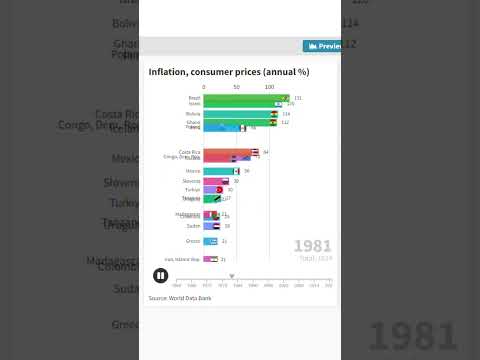
Source: World Data Bank
In this comprehensive analysis, we will explore the inflation rates of all countries from 1960 to 2020, highlighting the key drivers of inflation, the economic impacts of high inflation, and the strategies that countries have used to control it.
Understanding Inflation
Inflation is often measured by the Consumer Price Index (CPI), which tracks the price level of a basket of goods and services that are commonly consumed by households. If the CPI increases over time, it indicates that the purchasing power of consumers has decreased, as they need to spend more money to buy the same amount of goods and services.
Inflation can be caused by various factors, including:
Increase in production costs, such as wages, energy, and raw materials, which can lead to higher prices of goods and services
High demand for goods and services, which can result in shortages and price increases
Increase in money supply, which can lead to a decrease in the value of currency and an increase in prices
Global Inflation Trends
Looking at the global inflation trends from 1960 to 2020, we can see that inflation rates have fluctuated significantly across countries and time periods. For instance, during the 1970s and early 1980s, many countries experienced high inflation rates, known as the "inflationary spiral," which led to economic instability and social unrest.
In contrast, during the 1990s and 2000s, many countries adopted monetary policies aimed at controlling inflation, leading to lower inflation rates globally. However, some countries, especially in Latin America and Africa, continue to struggle with high inflation rates, which pose significant challenges to their economic growth and stability.
Economic Impacts of High Inflation
High inflation rates can have numerous negative impacts on an economy, including:
Decreased purchasing power of consumers, which can lead to a decrease in consumer spending and economic activity
Reduced investment and business confidence, as inflation can create uncertainty and volatility in financial markets
Increased production costs and reduced competitiveness, as firms have to spend more money to produce goods and services
Decreased value of currency, which can lead to capital flight and exchange rate instability
Strategies to Control Inflation
To control inflation, countries can adopt various monetary and fiscal policies, such as:
Monetary policies: Central banks can increase interest rates to reduce the money supply and control inflation. Alternatively, they can decrease interest rates to stimulate economic activity and increase inflation rates.
Fiscal policies: Governments can reduce public spending and increase taxes to reduce inflation. Alternatively, they can increase public spending and decrease taxes to stimulate economic activity and increase inflation rates.
Exchange rate policies: Governments can adopt a fixed or flexible exchange rate system to control inflation. A fixed exchange rate system can help to stabilize prices but can lead to currency overvaluation, while a flexible exchange rate system can lead to exchange rate volatility but can help to adjust to external shocks.
Conclusion
Exploring the global inflation trends from 1960 to 2020 highlights the complex nature of inflation and the challenges it poses to the global economy. Understanding the drivers of inflation, the economic impacts of high inflation, and the strategies to control it is crucial for policymakers, investors, and anyone interested in the world's financial market. By analyzing the inflation rates of all countries, we can gain valuable insights into the factors that contribute to
economic stability and growth, and the strategies that countries have used to control inflation and achieve macroeconomic objectives.
Overall, this comprehensive analysis of global inflation trends provides a valuable resource for anyone interested in understanding the complexities of inflation and its impact on the global economy. By examining the historical trends and current issues surrounding inflation, we can gain valuable insights into the strategies and policies that countries have used to address inflation, and the potential future trends that may impact the global economy.
Furthermore, this analysis can help inform decision-making in both the public and private sectors, by providing insights into the economic and financial risks and opportunities associated with different inflationary environments. By staying informed about the latest trends and developments in inflation, investors, policymakers, and business leaders can make informed decisions that support long-term economic growth and stability.
Did you miss our previous article...
https://trendinginbusiness.business/trending-videos/gerald-celente-the-collapse-that-will-change-a-generation
.png)





